Tiger population grows 50 per cent in Thai wildlife sanctuaries
BANGKOK — A recent increase in the Indochinese tiger population living in western Thailand’s Thung Yai-Huay Kha Khaeng wildlife sanctuaries show the country is making progress in protecting the endangered species, says the Department of National Parks, Wildlife and Plant Conservation.
BANGKOK — A recent increase in the Indochinese tiger population living in western Thailand’s Thung Yai-Huay Kha Khaeng wildlife sanctuaries show the country is making progress in protecting the endangered species, says the Department of National Parks, Wildlife and Plant Conservation.
Dozens of tigers are now living in forests nearby the Unesco World Heritage-recognised sanctuaries in Uthai Thani, Tak and Kanchanaburi provinces — places where there never used to be tigers, according to Dr Saksit Simcharoen, academic head of the Wildlife Conservation Office’s Regional 12 based in Nakhon Sawan province.
Over the past decade, the Indochinese tiger population in the wildlife sanctuaries has increased 50 per cent, from an estimated 40 tigers in 2005 to 60 tigers this year, says the department’s figures.
In Mae Wong National Park alone, there are now 10 new tigers, said Dr Saksit, adding that other parks experiencing the relative boon in tigers are Mae Wong National Park in Nakhon Sawan province, Salak Phra Wildlife Sanctuary and Khuean Srinagarindra in Kanchanaburi National Park and Chaloem Rattanakosin National Park in Kanchanaburi province.
The total tiger population in Thailand is between 189 to 252, living in 10 forest complexes and 31 wildlife sanctuaries nationwide, according to the department’s figures.
Meanwhile, in the Greater Mekong region, covering Thailand, Cambodia, Myanmar and Vietnam, only 350 tigers remain, and worldwide there are as few as 3,200, according to World Wildlife Fund (WWF).
The rise in the tiger population in Thailand shows the government is delivering on a commitment made at the Tiger World Summit in 2010 in St Petersburg Russia, to increase the tiger population by half by 2022.
“I am not fixated on the target itself [to increase the population by half], because as long as there are people working for tiger preservation, there will be tigers in the forest,” Dr Saksit said.
The department pledged on National Tiger Conservation Day last Wednesday (July 29) to strengthen forest patrols to stop animal poachers and work together with local communities to preserve and protect tiger habitats.
As part of a larger plan to develop a tiger population database, the department also plans to study populations in the Dong Phayayen-Khaoyai Forest Complex, home to an estimated 30 wild tigers, and considered Thailand’s second largest home for the big cats.
In February, Thailand was voted the fourth-best country worldwide on tiger management at an international symposium hosted by the WWF titled “Towards Zero Poaching in Asia”, and held in Nepal.
“Without anyone to do the job to protect the tigers, there would not be any left,” Dr Saksit said. THE BANGKOK POST










